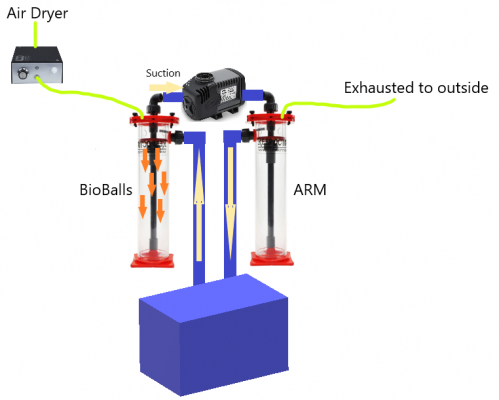Hi all! I am designing an ultra low maintenence Ozone system and would love anyone's input.
Purpose: To design an Ozone chamber to provide Ozone to my 60g reef aquarium (in process) with the goal of water clarity and intermittent breakdown of organic wastes. In my design I am attempting to produce an ultra low maintenence system that doesn't require constant ORP monitoring 24/7 and does not require changing carbon filters.
Design:
Ozone generator - Poseidon 200
Air Pump - AL-6SA In-Line Vaccum Air Pump
Reaction Chamber - Reef Octopus BR-110
Reaction Chamber Media - BRS polypropylene bioballs
Ozone exhaust chamber - Reef Octopus BR-110
Exhaust chamber Media - ARM coarse aragonite media
Pump - SICCE Syncra 0.5
Key Points:
1. Dry air pulled into Poseidon from suction from the SICCE pump
2. Ozone fills the BR110 chamber #1
3. Water is pulled over the bioballs to increase contact time
4. Ozonated water is pulled up the center of BR110 chamber #1
5. Water is pumped down the center of BR110 chamber #1
6. ARM media allows increased contact time for ozone to exit water
7. Water overflows BR110 back into tank
8. Air that enters chamber #2 is exhausted to the outside
9. System is only ran at night for 3-4 hours
Questions:
1. Will the suction from the SICCE pump be strong enough to pull water up into Chamber #1 (after being primed), or do I need a second to feed the system? Or should I just move the pump to before Chamber #1? I didn't want to do this because then it would create a positive pressure chamber that could (theoretically) backup into the ozone generator and I would then need an air pump
2. Will the suction from the SICCE pump be strong enough to pull air through the Poseidon, or do I need an air pump
3. Will the second chamber need to be filled with carbon or does the ARM provide enough contact surface to allow the Ozone to exit by the time it reaches the top of chamber #2 (or is this theory completely bogus)
4. Since I don't care about ORP in the tank, my main goal is the breakdown of the organic molecules for both water clarity and for east of my denitrifying bacteria to uptake the broken up organics, but do I need to monitor ORP anyway?
5. Since I am exhausting the second chamber outside, I shouldn't need a carbon filter on the exhaust airline, but is there a reason to put one anyway?
6. Do I need a carbon filter on the water return side? This seems to be a highly debated topic...
Anyways, I will be putting this system together to test in the next couple of weeks. I will be using this on a Red Sea 300 XL system that will have both fish and LPS/Softies.
Thanks again for anyone's input!!

Purpose: To design an Ozone chamber to provide Ozone to my 60g reef aquarium (in process) with the goal of water clarity and intermittent breakdown of organic wastes. In my design I am attempting to produce an ultra low maintenence system that doesn't require constant ORP monitoring 24/7 and does not require changing carbon filters.
Design:
Ozone generator - Poseidon 200
Air Pump - AL-6SA In-Line Vaccum Air Pump
Reaction Chamber - Reef Octopus BR-110
Reaction Chamber Media - BRS polypropylene bioballs
Ozone exhaust chamber - Reef Octopus BR-110
Exhaust chamber Media - ARM coarse aragonite media
Pump - SICCE Syncra 0.5
Key Points:
1. Dry air pulled into Poseidon from suction from the SICCE pump
2. Ozone fills the BR110 chamber #1
3. Water is pulled over the bioballs to increase contact time
4. Ozonated water is pulled up the center of BR110 chamber #1
5. Water is pumped down the center of BR110 chamber #1
6. ARM media allows increased contact time for ozone to exit water
7. Water overflows BR110 back into tank
8. Air that enters chamber #2 is exhausted to the outside
9. System is only ran at night for 3-4 hours
Questions:
1. Will the suction from the SICCE pump be strong enough to pull water up into Chamber #1 (after being primed), or do I need a second to feed the system? Or should I just move the pump to before Chamber #1? I didn't want to do this because then it would create a positive pressure chamber that could (theoretically) backup into the ozone generator and I would then need an air pump
2. Will the suction from the SICCE pump be strong enough to pull air through the Poseidon, or do I need an air pump
3. Will the second chamber need to be filled with carbon or does the ARM provide enough contact surface to allow the Ozone to exit by the time it reaches the top of chamber #2 (or is this theory completely bogus)
4. Since I don't care about ORP in the tank, my main goal is the breakdown of the organic molecules for both water clarity and for east of my denitrifying bacteria to uptake the broken up organics, but do I need to monitor ORP anyway?
5. Since I am exhausting the second chamber outside, I shouldn't need a carbon filter on the exhaust airline, but is there a reason to put one anyway?
6. Do I need a carbon filter on the water return side? This seems to be a highly debated topic...
Anyways, I will be putting this system together to test in the next couple of weeks. I will be using this on a Red Sea 300 XL system that will have both fish and LPS/Softies.
Thanks again for anyone's input!!
















